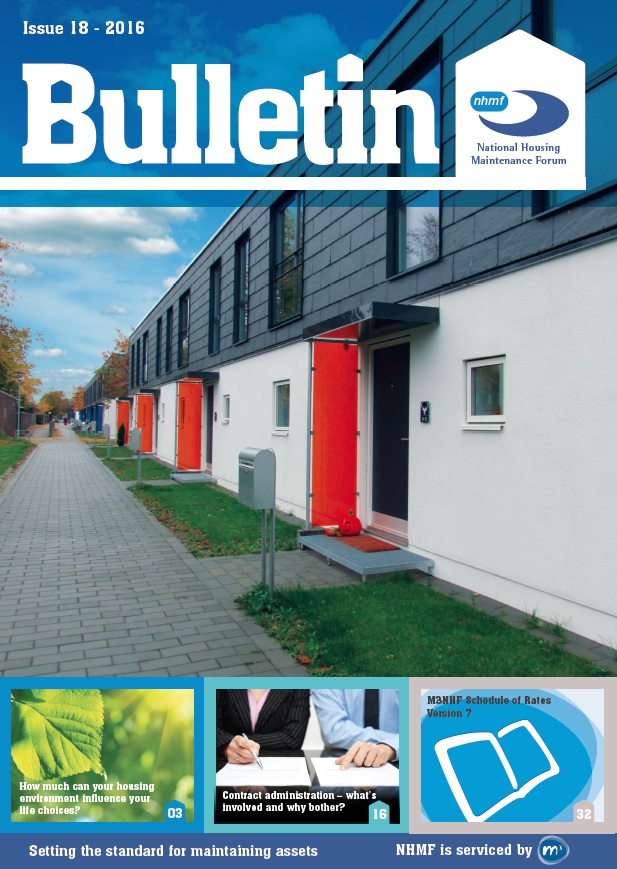NHMF best practice
These two new best practice sections will help social landlords to maintain quality homes in an increasingly challenging economic environment. The Compliance Section has a set of topical guides summarising social landlords’ responsibilities for meeting essential statutory health and safety requirements and explain how to do this economically and efficiently. The Fuel Saving Section explains how to include a fuel saving strategy as a key aspect of an organisation’s business plan. The Guide then sets out how to develop a practical improvement strategy as an integral part of the asset management programme and how to successfully deliver the improvements and manage the risks. There are also best practice training courses which relate to this guide.
Chapter 3: Presenting the fuel-saving strategy to the governing body
Having undertaken the detailed analysis to establish the proposed fuel-saving targets (see Chapter 2), it is essential that the results are presented to the Governing Body in social business terms with quantified outcomes.
This should build on the information that secured their initial agreement, starting with a review of what is already in the business plan i.e. the current asset management programme’s planned expenditure and what it is intended to achieve. An assessment of how the stock is performing should draw on the detailed analysis above, in addition to housing management and customer services data, including KPI data and NPVs.
Stock KPIs should be related to:
- The business plan, such as income generated
- Energy performance, such as average and minimum SAP energy ratings and average and maximum carbon dioxide emissions
- Residents’ experience, such as the incidence of fuel poverty, the number of reactive repairs, rent arrears and void levels
Business risks arising from the current asset management programme should be identified, quantified and assessed.
For example, is the incidence of fuel poverty or are rent arrears increasing and why? Future business risks should be considered using scenarios, such as different rates of increase of domestic fuel prices based on Government predictions, and how they might impact on rent arrears.
The Government’s 2015 Summer Budget announced that rents in social housing in England will be reduced by 1% per year for four years from April 2016 and will apply to both social and affordable rent.
The Government suggests that this will result in a 12% reduction in average rents by 2020/21, compared to current forecasts. Housing associations’ business plans are based on the existing ten-year rent settlement but the National Housing Federation estimates that a reduction of 1% each year for the next four years would reduce social landlords’ rental income by £3.9bn. As a result, future rental income will be less than had been included in business plans.
The Budget also announced a raft of measures designed to lower the annual welfare budget in England, which will be phased in over three years. The bulk of the savings are to be found through a freeze to working-age benefits.
Some households, including working families, will face significant reductions in their income. Proposals directly related to Housing Benefit include new Universal Credit claimants aged 18-21 no longer automatically being entitled to claim and the family premium being removed from new claimants and new children. A new Household Benefit cap of £20,000 (£23,000 in London) is proposed. Rent will no longer be paid direct to landlords for benefit claimants. These changes will put pressure on income recovery for social landlords and are likely to result in increased rent arrears.
Reduced rental income will be compounded by the probability of rent arrears increasing because of the new benefit caps. Furthermore, operating costs are likely to rise with the introduction of the National Living Wage and the "Right to Buy" policy. An assessment should be made of how big these reductions are likely to be, and they should be factored into future business planning and risk assessment. Other factors that could affect rental income include rising energy and utility bills, as well as increasing service charges.
Accurate, up-to-date demographic information will be an important aspect of this assessment because the welfare reform changes do not affect pensioner households as much as others. However, they may be more at risk of fuel poverty if they are living in former family homes with poor energy performance that will be relatively more expensive to improve in a way that will protect pensioners from fuel poverty. Where this demographic and stock analysis shows that pensioner households cannot be protected from fuel poverty because of the type of property they are living in, consideration of how best to house older and vulnerable residents should inform both the asset management and development strategies. This analysis should be included in any presentation to the Governing Body.
The proposed strategy to reduce fuel use and associated targets can then be presented in terms of how business risks could be reduced and what outcomes could be achieved, such as improved EPCs or SAP energy ratings or reduced incidence of fuel poverty.
The additional costs of delivering the proposed fuel saving strategy as part of the asset management programme are often marginal compared with the current retrofit approach. The cost of fuel saving measures should be presented against the total current asset management budget so that the proposed additional costs can be seen in perspective. A sensitivity analysis of any proposed additional expenditure needs to be modelled in the overall business plan to assess any effects on interest cover, cash flow deficit, and net debt per unit. Most of these items are connected with loan covenants which cannot be exceeded.
An assessment could be presented, based on current Government policy, as to what funding might be available for measures to reduce fuel use but external funding should not drive the strategy. It is essential that the fuel saving targets and funding are built into long-term business plans and budgets so that they will always support fuel saving improvements. A strong social business case will be required to secure the necessary budgets to improve existing stock with the challenges on available finance and the pressure to build more new homes.
It should also be possible to identify the cost savings from strategically integrating the measures to reduce fuel use into the asset management programme as opposed to carrying out the improvements as a separate retrofit programme. The costs of installing external wall insulation during a window replacement programme or external decoration would be significantly reduced because there would be no need for additional scaffolding. However, varying existing contracts in such a way would need to be carefully considered, for example, the scaffolding would need to be erected earlier to allow time for external wall insulation to be completed. External insulation and other fuel saving improvements are specialist work (see Chapter 6) and so the capabilities of the existing contractor and the capacity to vary the existing contract to include the necessary specialist expertise need to be assessed. A further factor to be considered is any need to consult leaseholders about the proposed improvements. These criteria, and any other enabling works required for energy efficiency works, should be included when cyclical maintenance and planned works contracts are re- tendered.
The stock analysis should identify how measures to reduce fuel use could best be integrated into the asset management strategy, i.e. identifying what work is already planned (e.g. boiler or window replacements) and what the marginal costs are of enhancing specifications and adding other fuel saving improvements.
This would demonstrate how short, medium and long-term (whole-house) energy performance targets could be achieved most economically and efficiently. The business benefits of this approach can be presented in terms of value for money and also reduced disruption for residents since the measures to reduce fuel use would be installed as parts of integrated contracts.
However, it will be important to keep this under review, in order to exploit opportunities to meet targets as circumstances change and funding opportunities become available.
The Governing Body should be made aware that a flexible approach will be required and should provide Asset Management and Investment Directors with the necessary autonomy so that opportunities and/or funding are not missed. Any changes to the programme should be carefully considered to assess whether the costs and disruption are worthwhile. There have been examples of landlords bringing forward work to capitalise on short-term funding opportunities but these have not been as financially beneficial as expected.
While funding regimes and incentives have appeared attractive, they may not be a reliable basis for delivering measures to reduce fuel use.
Many had short, uncertain timescales and frequent policy changes implemented at short-notice. This experience showed the risks of an over-reliance on funding schemes i.e. basing fuel saving strategies on external funding ("chasing the money") rather than on assessed business needs. The strategy to reduce fuel use should be based on what is right for the business and the residents, with external funding considered when it helps achieve the agreed objectives and does not distract the organisation in an unintended direction.
However, with an agreed strategy, funding opportunities and incentives can be assessed as to whether they will help to deliver the planned fuel saving improvements.
To utilise such funding and incentives, it is essential that improvement projects are sufficiently developed, with quantified outcomes, that they can be implemented quickly to meet funding timeframes and before funding budgets are exhausted or the policy changes.
For a strategy to reduce fuel use to work, the whole organisation, not just the Governing Body, should be able to see the benefits of and be committed to delivering it.
It may be appropriate for a Governing Body member to be made responsible for championing the strategy and ensuring sufficient senior management ownership to deliver it. Furthermore, all residents (leaseholders as well as tenants) need to be engaged and convinced so that they agree to the work and participate willingly. Some landlords have integrated energy advice and third party support agencies, such as Citizens Advice Bureau, when engaging residents and keeping them on board, particularly around things like tariff switching. Others have found residents’ awareness of the benefits of more energy efficient homes has resulted in positive responses to fuel saving improvements, even when costs and disruption are involved. Housing management and customer services teams, together with third party support agencies, have key roles in working with residents to support and facilitate the delivery of improvements and making sure the benefits are realised. They should also promote behaviour change by providing fuel saving advice to residents during and after improvements so that they benefit by having homes they can afford to heat.





